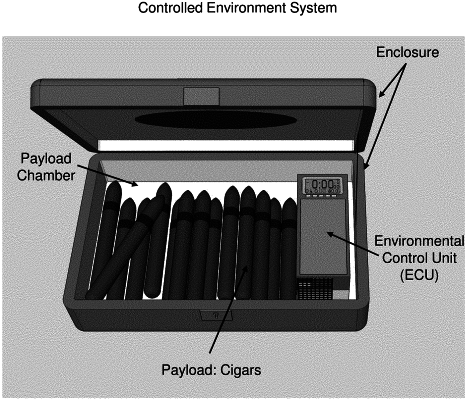| CPC A24F 25/02 (2013.01) [B65D 81/18 (2013.01); B65D 85/12 (2013.01); F24F 3/14 (2013.01); A24F 15/12 (2013.01); F24F 11/0008 (2013.01); F24F 11/56 (2018.01); F24F 2006/008 (2013.01); F24F 2110/20 (2018.01); F25B 2500/18 (2013.01); F25B 2500/19 (2013.01)] | 24 Claims |

|
1. An apparatus for monitoring and controlling an environment inside a container defining a payload chamber, comprising:
a plurality of environmental control units disposed within said payload chamber,
wherein each of said environmental control units comprises a humidity sensor, a humidifier, a dehumidifier, and an environmental control processor,
wherein each of said environmental control processors is configured to receive one or more input signals from said respective humidity sensor,
wherein each of said environmental control processors is configured to transmit control signals to said respective humidifier and to said respective dehumidifier,
wherein each of said environmental control processors is configured to execute an algorithm for monitoring and controlling said environment within said payload chamber based on said respective input signals by generating said respective control signals so as to substantially maintain a first humidity level,
wherein two or more of said environmental control units are configured to function in unison to substantially maintain said first humidity level,
wherein each of said environmental control processors is configured to receive a mode select signal that determines whether said algorithm executes in a first mode comprising a first operating rate so as to conserve power or in a second mode comprising a second operating rate that is faster than said first operating rate, and
wherein each of said environmental control processors is configured to receive a calibration mode select signal that determines whether, instead of executing said algorithm, each of said environmental control processors executes in a calibration mode to improve the efficiency of said algorithm.
|